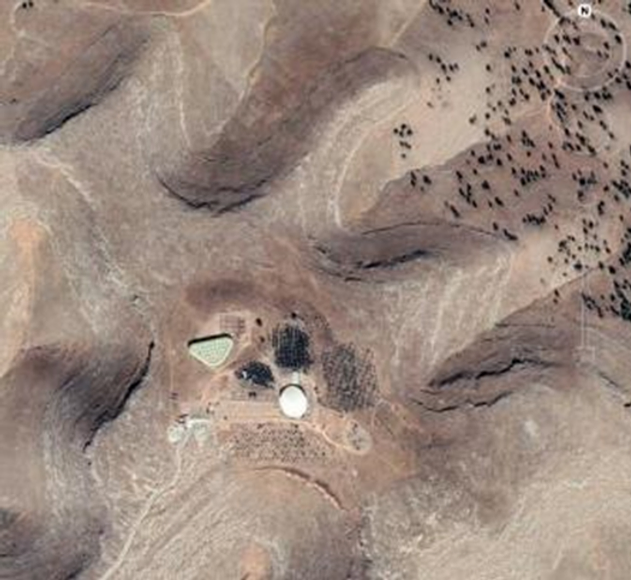Table of contents
PURPOSE OF THIS ARTICLE
As we understood from the previous article summarizing the archaeological discoveries made on this site, despite the numerous discoveries that reveal so much about its true nature, the majority of archaeologists still support the hackneyed scientistic interpretation of a temple built by somewhat “primitive” hunter-gatherers who, after their discovery of agriculture in the Neolithic period, engaged in the first agricultural rites linked to the course of the sun.
Let’s face it, from the point of view of cultural knowledge of the sacred world, this is a veritable intellectual aberration and cultural heresy if we know anything at all about universal mythological symbolic language, the meaning of the symbols our ancestors used to convey their teachings, their doctrines, their worship, their religion.
Using this symbolic language, we’re going to “translate” this site and clearly state what it represents, through its architecture, ornamentation and related findings.
As it unravels, one by one, all the enigmatic knots that have so far contributed to its mystery, this deciphering will, I hope, progressively open the eyes of novices in sacred science, tourists and anyone legitimately amazed by this site, but also, therefore, the eyes of the archaeological community.
Let’s take a look at this site and see how, in comparison with other megalithic sites, it too conveys the same strict teachings and doctrines of prehistoric mythological religion (or prehistoric paganism), including its major doctrine: the immortality of the human soul through the celebration of the death and reincarnation of the father of the gods (the deified primordial man) into his son, the son-god; a rebirth brought about by the regenerative power of the womb of his wife, the mother-goddess (the deified primordial woman).
Our analysis of this site is yet another illustration of the fact that, even if each megalithic site is different in that it declines the sacred symbolic language of mythological religion according to its local specificities, favoring certain symbols over others, fundamentally, they all use the same sacred symbolic language that conveys the same original mythological prehistoric doctrine or religion.
This example, coupled with the analysis of other megalithic sites, will give us a better grasp of the universality and timelessness of prehistoric mythological religion (or paganism).
LINK THIS ARTICLE WITH THE ENTIRE LITERARY SERIES “THE TRUE HISTORY OF MANKIND’S RELIGIONS :
We have summarized everything that has been said or discovered about the Göbekli Tepe site in a separate article, also available on this site:
GÖBEKLI TEPE: SUMMARY OF ARCHAEOLOGICAL DISCOVERIES
article also taken from the book available on this site:
The megalithic temples of Malta, Göbekli Tepe and Stonehenge
You can also find this book here :
Already published books
To find out why this book is part of the literary series The True Stories of Mankind’s Religions, go to page :
Introduction / Structure and Content
I hope you enjoy reading the full article below:
DATE FROM – 9 600 BC. J.-C. / GÖBEKLI TEPE IN TURKEY
THE EXPLANATION OF THE PURPOSE OF THE SITE
LOCATION
A SITE NEAR THE KARAKA MOUNTAIN Dağ
Already, this site refers us to the symbolism of the mountain and the volcano since it is mystically linked to the mountain named Karaca Dağ, a volcano in southeastern Turkey.
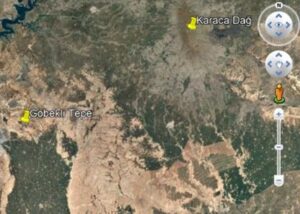
The symbolism of the mountain as well as that of the volcano is well known.
Let’s just say here that one is essentially the representation of the womb of the mother goddess whose cave is the womb, the uterus, and the second the symbol of this same womb pouring out its fluids, its blood.
As a brief reminder of its etymology, the mountain is said:
(see the phoneme index of Sumerian volume 3)
- Iši, which is a homonymous phoneme of isi (clay pit), izi (fire) iš (ancestor), the very source of the name Isis.
And also
- Kur, a phoneme that designates a mountain, a high plateau: a (foreign) land; but also the underworld, being according to the Halloran lexicon the contraction of “ki” “place” and “ùr” a “roof, mountain pass” or úr “root, base”. In its verbal form, kur means to reach, to arrive, to access; to light, to ignite, to rise (the sun).
I cannot detail again here all the meanings of kur/gur which is one of the most important Sumerian phonemes in that it includes all the phases of gestation-generation.
Let us simply note here that “ki” does not simply designate a place in Sumer. It is also the name of the Sumerian earth goddess.
So that basically, the mountain designates the womb of the goddess of the Earth Ki-Isis, who became the mother-goddess of the underworld and whose womb allows the father of the gods, who was also put to death, to be regenerated into their son, and by extension, to all the descendants of his devotees to be regenerated after their death, in order to allow them to rise, and to reach divinity like star-suns.
This mother goddess is even referred to by name in the name of the mountain: Karaca Dağ.
What does this name mean?
It is normally very easy for you now to break it down and understand its meaning, but I will do it for you:
Let’s decompose the first one into ka-ara-aka
Etymology of “ka”:
(see for more details the symbolic index of the phonemes of Sumerian available in volume 3):
ká is a homonym of “ka” which means “mouth”.
Hence the association of the door with the symbolism of the mouth (cf. the mouth)
Given the strict equivalence between “g” and “k”, “ká” “ga” and “ka” are the contraction of :
“g” or “k” “tank” or
“gíg, ñíg, gi6, ge6, ñi6, ñe6, mi, mé, ku10, gi25” which all mean “night” and are represented by the throat cavity or mouth closed like a dark room. The associated verb is to be black or to be dark (ku10) and the associated adjectives are black, dark (cf., kúkku). Moreover, the term associated with black is “kúkku” which also has the meaning of “ancestor”.
And from:
“a” “water, sperm, father – ancestor” or “aa” father, but also
“á” which means the side, the arm and which designates the goddess of the side Eve (review the symbolism of the goddess of the coast, the side).
Thus ká is the womb, the dark and humid cavity, the reservoir of water, of sperm, of the goddess of the side containing the father-ancestor.
This allows us to understand the symbolism of “ga” milk and its real mystical origin, namely the matrix, mainly of the mother goddess.
Etymology of “ara
(see for more details the symbolic index of the phonemes of Sumerian available in volume 3):
“ara” means both to pulverize, to destroy (by ara 3,5) and to shine, to blaze by ara4 (or ar or rà). “…” (hence the solar name of the Egyptian god ra, object of the cyclic regeneration)
Note also that “ar” alone with its strictly equivalent homophones (re7; ri6, rá, ir10; e-re7; er, ir) has many meanings, the most significant of which are to accompany, to lead, to carry, to go,…, to stir, to mix or to place, to pour, to put in… to emit, to engender, to flood, to take, to gather.
rí for example is an equivalent of uru2, (ki), iri, iri11 which mean a city, a town, a village, a district. (hence the name of the Sumerian city of Ur)
So that “ar” conveys all the actions that the matrix is supposed to produce for the benefit of the Father of the gods and their deceased worshippers in order to transform them into star-divinities as the fact of gathering the living in cities and towns, being the object of the feeding by its waters, fluids of abundance.
Etymology of “aka
(see for more details the symbolic index of the Sumerian phonemes available in volume 3; as well as the analysis of the name of Eve with the different possible transliterations of its Sumerian forms)
This phoneme which is very important in that it designates Eve by name has been explained in the analysis of Eve. See also the index.
Eve-aka-aga:
Let us simply say here that “aga” or “aka” is indeed, as we have seen in book 1, one of the Sumerian transliterations of the name “Eve”.
This term designates her by name as the mother who begets, aka being equivalent to ùgun, ugu4 (with the cuneiform sign “ku”) which mean to carry to produce procreate.
ama-gan or ama-ugu is a natural or biological mother contraction of “mother” and ùgun, ugu4, “to generate”.
agarin2,3 means for example a father, a mother, a womb or a uterus.
Among the many examples listed in this analysis, let us note that, for example, even today, akka means mother in Sanskrit:
Here are the different variations of the root AK in Sanskrit:
अ A, in the monosyllable ôṃ, represents viśṇu.
अ क् In K. akâmi –) means to go tortuously, to wind; to act in a tortuous way. Gr. ἀγής, ἀγϰύλος (agês, agkulos).
अक AKA – ) n. sin, fault; ‖ sorrow, grief.
अक्का AKKÂ –) f. mother.
https://fr.wikisource.org/wiki/Dictionnaire_classique_sanscrit-français/अ
https://sanskrit.inria.fr/Heritage.pdf
It is therefore clear that Akka means mother with a contemptuous consonance, no doubt related to the notion of fault, sin and sorrow that the original mother conveys.
Coastal Goddess:
But “aka” is not content to call the mother goddess by her name.
He also points to her as the goddess of the coast or side!
In fact, aka means “the door-matrix of the coast, the side” since “á” means the side and “ka” the door
Now it has been shown that Eve was worshipped as the goddess of the coast, of the side, by means of certain precise Sumerian homophones that we find underlying their respective symbols (review the symbolism of the goddess of the coast, of the side).
Matrix:
But aka also designates its matrix being homophone of “remote room ” (a-ga) “door (ká), “door lintel (“ákan, aka4”), “fleece (aka) which are also separately symbols of it.
Let’s recall for example the “a-ga” remote room:
The homonym of “a-ga”, “dag” refers to a room where one resides similar to a cavity in which one is in motion while traveling. Dig refers to being wet like a throat or vagina. Dug is a jar or pot, and dùg or du10 means limbs so those in the form of a cavity like the throat or vagina where there is movement and in its verbal form it means to have pleasure.
With a-ga we are indeed “facing the matrix” of the mother-goddess.
Let us recall for example the door a-ka or the door lintel ákan, aka4 :
“aka” is also the womb that carries “a” water, sperm or father, or the Sumerian father of the gods “An”, in the double sense of carrying him in her womb and also raising him, challenging him.
It is indeed extremely interesting to note that, just as in French we say “la porte” (from the Latin porta, “door of a city, of a monument”, which supplanted the words fores and janua), but also “porter” (from Latin portare) in the sense of carrying a child and also in the sense of “to carry, to raise, to elevate”, it is exactly the same in Sumerian
Indeed, as we have just (re)seen aka means door, but under a-ka its equivalent is úgu4 (KU) which means to carry produce procreate.
The Sumerian lexicon also indicates to gùr, ga6 that these two phonemes mean to carry, to transport; to be full, loaded, being the contraction of “g” a circular container and “er” “to bring”; see also gur, kùr, “basket”). The lexicon states that this is the same reading of Umma (a Sumerian city) for the sign “íla” “…”
Now íl-lá means elevation and in its verbal form íla, íli, íl the fact of lifting, carrying, delivering, bringing, enduring, supporting, “…”; to be elevated; to shine; lal, lá (la2) means to be elevated; to hold, to elevate, to carry, to suspend.
Thus, by this association between “ga” or “ka” and íl-lá it is not only a question of carrying in the sense of conceiving as a progenitor, but also of carrying, of elevating (carrying to the heights in a way) in the sense of deifying!
Do you understand a little better the mystical meaning of the volcanic mountain “karaca” to which Göbekli Tepe, in the opinion of the observers, is intimately associated?
It is a sanctuary, like many sacred mountains, but not a “cosmic mountain” as one reads here and there almost systematically about the mountain.
It is neither more nor less than the body of the woman, ancestor, “iš, iša”, of the ancestor (ku; kúkku) mother-generator (Sumerian: aka ùgun, ugu4; ku; ama-gan, ama-ugu; agarin2,3 / Sanskrit: akkâ) of the primitive companion under the rib or side (á) of the future Earth goddess Eve/aka/aga deified under Isis, Ki, who after acting in a tortuous way (Sanskrit: akâmi) after her fault and sin (Sanskrit aka) was thrown into the underworld (kur), transformed into a rock goddess, a mountain (iši, kur) and who, thanks to her matrix (ká, ga, ka; a-ga; ákan, aka4; aka), her cave (review the symbolism of the cave) is able to carry (úgu4 (KU); gùr, ga6), to generate (ùgun, ugu4), to regenerate and to raise (íl-lá; íla, íli, íl ; lal, lá (la2) to the rank of god her husband (An-a-aa) and, to do this, to first pulverize him, destroy him (ara 3,5) to stir him up to mix him, to churn him (ar ; rá) in order to make him shine and blaze (ara4 or ar or rà) like a god-star-sun (such as Ra), which will also have the effect of engendering, gathering, flooding (understanding his fluids) his worshippers into cities, towns, villages, districts [rí, uru2, (ki), iri, iri11].
As for the analysis of the term Dağ attached to this mountain I refer you to the symbolic dictionary of phonemes or the analysis of the goddess of the side/coast, the symbolism of the goddess who ties with ropes, the analysis of the Celtic god Dagda made in the analysis of the cauldron…
Let’s just understand that this term is a repetition of the previous one with other symbols.
This said, having already situated the context, let us now focus on the site of Göbekli Tepe in itself:
THE SYMBOLISM OF THE SITE ITSELF
To understand this site located on a height, at 760 m, that is to say at the highest point of the Germus mountains, it is advisable, as often, to take us also of the height while keeping in head what was already shown in terms of symbolism of the hand.
Here is the site of Göbekli Tepe seen from above.
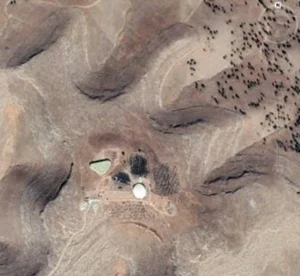
Now tell me, what do you see?
Nothing? Except for the elements of the site?
Please. Remember what was seen in the previous chapter and insist.
Still nothing?
Please take a good look at the shape of the mountains on which the site is located.
The mountains?
Yes, this aerial view creates an optical effect and one can have the impression that the mountains are hollow
So, here is another view allowing you perhaps to see better that the site is indeed on a height:
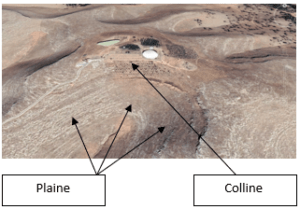
The following view will help you to understand the extent of the artificial mound that has been built and that corresponds to the circle with a diameter of 300 meters of earth and 15 meters high, a mound of earth gathered there, which forms a belly on the rocky plateau at the top of these mountains, hence the name of belly hill or navel hill.
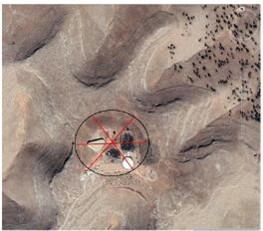
The following view will help you to understand the extent of the artificial mound that has been built and that corresponds to the circle with a diameter of 300 meters of earth and 15 meters high, a mound of earth gathered there, which forms a belly on the rocky plateau at the top of these mountains, hence the name of belly hill or navel hill.
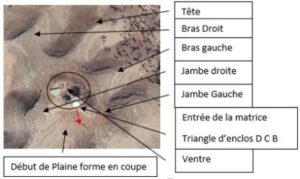
It turns out that the major site with its DCB enclosures forming a triangle facing southeast is right where the white area is at the bottom right (this major excavation site is covered by a protective white tent).
Here is a reminder of its layout if we lift the veil of the tent keeping the same north-south axis.
We can see that the triangle is pointing upwards on a slightly shifted North-West/South-East axis.
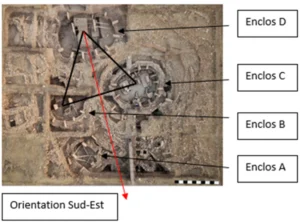
Do you see now and understand?
What shape is the hill?
Where is the 300 m diameter mound?
Where is the area of the BCD triangle?
Here’s what you should have seen by now:

Framed texts (top to bottom) :
Head
Right arm
Left arm
Right leg
Left leg
Matrix entrance (enclosure triangle D B C)
Belly
Incredible, isn’t it?
And yet, as we shall see, this site only respects the very simple logic of representing the mother goddess in her favorite mystical birthing position, under the universal and timeless symbol of the open hand (which also corresponds to that of the five-pointed star; see the complete symbolism of the star and the five-pointed star in volume 3) directing her fluids towards a U-shaped cup (here the plain)
What is quite extraordinary, it is that the builders knew how to use the relief of the places, the hill and the plain, relief that they had perfectly identified to come to place there at the opportune place the belly of the mother goddess and its matrix temples following, moreover, a plan of perfectly identified and mastered ordering.
Simple hunter-gatherers?
Hm Hm…
SYMBOLISM OF THE ENCLOSURES IN A TRIANGULAR FORMATION
Obviously, because of their triangular configuration, the structuring of these BCD temples evokes the entrance to the matrix as well as the elevation that it will make possible.
Moreover, each of these enclosures is probably itself, even independently of each other, a matrix in its own right in the manner of the different main apses revolving around the cross-shaped forms that we will see in the analysis of the Irish megalithic temples or the trefoil plans of the temples of Malta, where each apsis is in itself a mini-matrix temple of the mother goddess.
It is perfectly possible to imagine that in other places of this belly there are other identical matrix enclosures.
However, the stratigraphy of the site shows us that the DCB triangle is certainly not placed here by chance.
Let’s focus on this area of the stratigraphy:
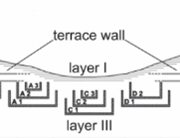
It is clear that enclosure C, which is obviously the major and central enclosure since it is multiplied with several internal enclosures, is located exactly in the center of the depression, let us say, exactly between the two legs that constitute the two sides of the mountain on either side…
Thus, the Turkish name of “belly hill” suits this hill perfectly [even if the most identifiable area is, still and always, esotericism obliges (!) that of the lower abdomen! ] since in fact the belly is nothing other than the belly of the mother-goddess of the mountain, of the rock in a lying or squatting position.
You will easily understand that this has very important implications given the very high antiquity of the site going back, according to experts, to the beginning of the Neolithic.
With this introduction, the rest, if you will pardon the expression, is obvious, but here again, in view of all that has been developed elsewhere, it is necessary to review them together
SYMBOLISM OF THE MOUND
From the outset, this site presents itself with the double symbolism of the mound and the mountain, since it is a mound placed at the top of a mountain.
Now, the symbolism of the mountain is by definition as has been said the representation of the mother goddess, under her status goddess of the Earth, of the rock and of the underworld, and, in the reclining position, the mountain represents her womb.
As for the mound (review the symbolism of the mound, of the tell…), it has been seen that it bears the same Sumerian name as the cave “dul6” which is one of the phonemes of regeneration and therefore one of the sites of the regeneration of the matrix of the mother goddess par excellence.
It has also been seen, among other things, that the etymological root of tumulus is Sumerian since “tumul” [the “us” is a Latin suffix] means “to make” “action of making, creating” “tum”, a star “ul”; in other words the role of the mounds, tumulus, tell… in the same way as the cave is to make, to create a star, that is to say to send the father of the gods put to death, but also all his deceased descendants in the stars after they have passed through the whole cycle of regeneration
From the outset, just with this symbol, we are therefore on a site dedicated to the regeneration of the father of the gods and his worshippers by means of the matrix of the mother goddess.
MEANING OF THE T-PILLARS
There is no doubt that the two central pillars are anthropomorphic representations.
Our analysis of the standing stones (review the symbolism of the stone, of the standing stones, of the obelisks) has demonstrated that they symbolize deified ancestors, whether they are the stones around the perimeter or those in the center, as is the case on all the other megalithic sites of the Cromelch type.
It was also noted by Mr. Dendrinos that the central stones of each enclosure obviously play a major role because of their size, their function (they apparently supported a roof), their location (in the center of attention) and the fact that they regulate the position of the enclosures and thus the possible representation of Orion’s belt; they also regulate the phasing with the summer solstice as well as the daily shadow game.
By himself, he identifies this fine follow-up game to that of a couple, especially since, as he specifies in his book, the two central pillars are not strictly of the same size, which suggests a (slight) preponderance of one over the other.
Let’s ask the question: given the general context of this work, and given that these two central T-stones necessarily allude to very ancient deified human ancestors who are lightly clothed in loincloths, what does this inspire in you as primitive historical characters (revisiting the symbolism of nudity, of clothing)?
I think the answer is in the question.
I can see all the scientists jumping up and down on their chairs and declaring that this is an interpretation made a posteriori of beliefs revisited in the light of my own Judeo-Christian beliefs.
The shortcut would obviously be, as it is, quite immotivated, if it were not surrounded by such a context and such a consistency of materials and proofs emerging not from the superficial and just intuitive reasoning of a believer armed with a vulgate in Greek-Latin, but rather from the extremely well-documented reasoning of a true believer, perfectly aware of the most ancient symbolic language and its mysteries, coupled with an intimate knowledge of the most ancient known language, the only one able to decode them.
What they have never read, nor known, nor even approached in their entire existence.
So they’ll have to sit back down after reading this book, like the previous and subsequent ones.
But let’s continue.
Let us recall in passing that Professor Schmidt wants to see in the figures represented by the pillars “supernatural beings”, while the other, smaller anthropomorphic representations unearthed at the site or in other sites of the same period (Nevalı Çori) would be a kind of “guardians of the other world”, of inferior status. According to this interpretation, the enclosures “symbolize human assemblies, and the standing stones, arranged in a circle, represent stylized figures.
https://fr.wikipedia.org/wik/Göbekli_Tepe.
Even if his interpretation is not very accurate, he understands that the central T-forms as well as those around the edge are characters. If he qualifies the central characters as supernatural beings, they have indeed become so since by definition the standing stones represent dead and regenerated ancestors who have become gods with the powers associated with them.
Who specifically represent the deities-ancestors, the T-stones that form the enclosure?
They may be important figures, high priests of the cult, who have been placed around the enclosure to delimit it, because they are symbolic protectors of the cult. They are not necessarily only guardians of the afterlife as Mr Schmidt says, because the fact that the gods are represented in this way is also to show that although they have become gods, they have made the choice (the sacrifice) to remain in the land of the living (humans) in order to guide them at the time of their death in the afterlife.
In fact, these spiritual entities dominate both worlds, the world of the living and the world beyond.
However, although the representation of deified high priests is possible, by virtue of the representations on the statues, where, apparently, each one bears here or there a more particular animal representation, it seems more necessary to interpret each of these statues as being a particular avatar deity, a deity deifying a particular facet of the two great central deities.
Let us not lose sight of the fact that the Father of the gods and the mother-goddess have been worshipped and represented in different forms. It is therefore perfectly natural that we find around them some of the main forms with which they deified and represented him. Each representation of an animal is intended to draw attention to a particular aspect of their person or life, just as in Judeo-Christianity, for example, bull, eagle, lion and man represent the four main divine qualities (power, wisdom, justice and love) of God.
Similarly, if we take the esoteric example of the zodiac (since Professor Dendrinos considers the hypothesis of a hexadecimal system based on the D enclosure which contains 12 orthostats, a system which may be valid for a solar calendar, but also for a zodiac) and its 12 signs: Aries, Taurus, Gemini, Cancer (which is none other than the crab), Leo, Virgo, Libra, Scorpio, Sagittarius (an archer on a horse), Capricorn, Aquarius, Pisces… the presence of a zodiac with its animal representations would have absolutely nothing very surprising. Indeed, it has been fully demonstrated that all these signs are avatars of the father of the gods and/or the mother goddess, under one or the other of their specific characters (see in volume 3 the respective meaning of each of these signs or in book 1 of volume 2, for example, the symbolism of the crab, the bull, the ram, the fish, the horse).
What is there then astonishing, frankly ? when we know that the first human couple, or even go, without speaking about him, even the gods of mythology have all been adored under animal forms, to see here a first couple of primordial gods being represented by some of their respective animal representations, with some simply more ancient and thus just less well known ? (Those less well known will be taken up in the part to follow on the explanation of the animal representations and analyzed in the volume 3)
I remain for my part flabbergasted by such a short-sighted vision, which because it is based on the idea that this site is necessarily the work of hunter-gatherers, insists at all costs! not to question its theory to refuse to see the evidence that these animals are symbols of deities.
“As it is necessary that they are animists since we have decreed that the primitive peoples were all animists and well Göbekli Tepe is a site of animists so the animal representations are animals, no doubt…” seems to be the mantra that the observers of this site repeat to themselves not to see what however jumps to my eyes.
But let’s continue.
It is also interesting to look at the T-shape
I must say that first of all this T-shape inspired me to think that these deities could assume the shape of a horned deity and more exactly of a deer.
Here is an indication of what can be found on the site https://ci.wolfgangpetersen.net/1810-neolithic-rock-art-found-in-india.html
Or on the website of :
https://gurukulamtrust.wordpress.com/2013/05/ :
A new prehistoric site containing rock engravings has been discovered at Kappikunnu, near Pulppally, in Wayanad district, in addition to other engravings previously found in Edakkal and Thovarimala caves, both in Kerala.
The engravings are very similar to those on the walls of the Edakkal Caves in the Ambukuthy Hills.
Four figures, one with two deer facing each other and the other three abstract, were found carved into a rock. Other lines found in a small rock that may have been detached from the original rock also had engravings inscribed in the form of a harness. The rocks are located within the precincts of the Sree Veliyambam Kotta Sicva temple, a semicircular temple built in the 12th century, in the forest division of the southern part of Wayanad.
The engravings date back to the Neolithic period according to Gira Gratier, a Belgian researcher who was working in the area on her research project on the tribes of southern India. Upon learning of the discovery from the inhabitants, he approached the site and indicated that it could be a place where our ancestors performed ancient rites.
On the other hand, the director of the archaeology department in charge of the Edekkal Cave, explained that a recent exploration by his team in the area revealed the remains of a Neolithic axe, further confirming the theory that the engravings can be traced back to this period of our history.
Ms. Gratier stated that she believes that the engravings in the stone they could have been part of a large structure in the past. Moreover, the anthropomorphic style of the figures and other artistic elements of Edakkal is similar to the new engravings found.
Here is the photograph of the deer in question:
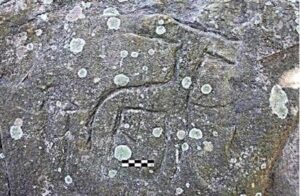
Note that in this representation seen from the front, his horns are represented horizontally from his head, forming a T!
Moreover, we are in the same temporal and cultic context of Göbekli Tepe: in the Neolithic, obviously also in the context of a temple of great structure (these rocks are besides always situated in a semicircular temple since at least 1200 BC). ).
It is obvious that at that time, when it was necessary to engrave in stone the image of a deer, the shape of the horns in T could be used.
The use of this form on this site would not in itself have been surprising, since it has been amply demonstrated that our first parents were deified notably under emblems of horned animals, such as the bull, the cow, the auroch, or the deer.
The stag being a real and formidable mystical signature of Adam (review if necessary the symbolism of the stag in this volume).
However, on closer inspection, the engravings on the central pillars of Enclosure D at Göbekli Tepe do not support this interpretation alone.
Indeed, the arms start from under the horizontal stone which attests that this one represents the head (look again at the photo in the part on the T pillars).
The arrangement of the arms gives us a valuable indication. The pillars are obviously turned in one direction.
On the photo, it is possible to see behind the central pillars the hole of the oracle which is located in the wall of the enclosure behind them (obviously this hole of the oracle had to allow to judge the position of the sun since it is directed towards the entry, entry which is itself directed towards the southeast).
Now this hole of the oracle is in the North (I invite you to go to consult the diagram carried out by Mr Dendrinos in his article which is extremely precise and useful also in this respect, but which I cannot allow myself to reproduce for preoccupation with the preservation of its rights; Gobekli Tepe: a 6 th millenium BC monument/Dimitrios S. Dendrinos/15/11/2016 p.14)
This means that the couple of gods faces the source of light for each enclosure, while the pillars around the perimeter have their stone “faces” facing them in the center.
In other words, the faces are on the edge of the T of each large orthostate (concretely, on the horns, if they were seen as horned deities of deer), and the whole structure serves secondarily to give it depth.
The first meaning remains that of seeing them from the front, that is to say their human representation, looking at them from the North.
Now, it is possible that the builders wanted to give them a T-shaped depth, by a second angle of view, to associate them with horned deities, which would be perfectly logical given the symbolism of the horns, of many horned animals, of the symbolism of the crown (which we find moreover on an adjacent orthostate), etc.
Let’s also add that this anthropomorphic T shape evokes of course the primitive cross, the tree of life, the Tau which is a very important symbol in more than one way (review the symbolism of the cross).
It is very likely that this representation in depth of perspective was also and especially used to signify this Tau cross.
As we will see in the section on shadow games, shadow is said ñišsu or ñizzu.
Now the particle ñiš designates in Sumerian an object, a tool, but it is also the very common word for tree.
This relationship between the tree and the shade it provides for the birds is a simple symbolism to represent the extent of dominion and protection these deities confer on their subject servants, both in their search for regeneration after their death, but also for an abundance of things during their lifetime.
In the very complete analysis of the tree (a hundred pages long) we understood, among other things, that Titan (whose first letter of his name is a Tau) as well as each member of the first human couple, were, all three, celebrated in their lifetime as “trees of Eden”. Then, after their rebellion, at the time of their condemnation to death by Michael, the Logos, as felled trees (review the symbolism of the stump, the log). Afterwards, by virtue of the fact that esoteric doctrine teaches their regeneration, as trees regenerated under different types of trees chosen specifically for this purpose (date palm, poplar, willow, fir, pine …). This regeneration was taught as happening at the winter solstice (around December 24, 25) and was also symbolized by the elevation of the star in the sky at the top of the tree (hence, of course, all the esoteric symbolism of Christmas which I cannot go into here; I am quoting these examples of symbols that you have already seen, so that you understand that for millennia the symbolic language as well as the doctrine it conveys has not changed…)
It was explained that this tree-man representation is evident from the etymology itself since “ñiš” or “ñeš” designates a tree, but also by “ñiš 2,3”, or “ñeš 2,3”, or “uš” “a man”.
There is thus a very solid symbolic chain between the human and his representation as a tree. In the same way there is a symbolic chain between the man and the deer and between the deer and the tree.
On this site which celebrates, as everywhere else on this type of site, the regeneration of the father of the gods (and also each of his deceased servants) into a being born again by the power of the matrix of the mother goddess, it is obvious that their representations to both in T to evoke their tutelary deity as the tree of life, the cross, or also, a horned deity, is eminently evocative and comes to “charge” the site with deep meanings.
The builders could certainly have been satisfied with erecting massive stones without cutting them, with for the father a particular monolith-obelisk of the type that we will see in Malta or in Stonehenge. In this case, this more precise representation allows us to give it “more weight”, which is probably what the builders were looking for. In any case, it allows us to identify it even more easily (in the center, as a couple, with a slightly larger size, both dressed in a simple loincloth), all the more so if we take into account all the surrounding context (head cut off on an orthostate, ithyphallic position as a sign of its self-generation…); stag, hind (horned, i.e. crowned), protective tree… all of this being major symbols, mystical signatures of the first deified human couple.
EXPLANATION OF THE PASSAGE STONES
The stones of passage and in particular the totem stone discovered on site is extraordinarily explicit.
I remind you:
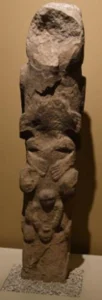
Tell me, what do you see
The obvious reading is this:
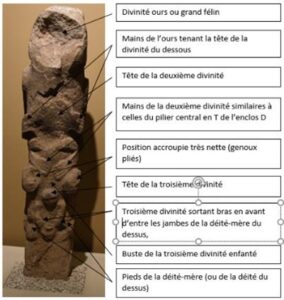
Texts in boxes from top to bottom :
- Bear or big cat divinity
- Hand of bear holding head of divinity below
- Head of second deity
- Hands of second deity, similar to those on the central T-pillar of Enclosure D
- Clear crouching position (knees bent)
- Head of third deity
- Third deity coming out with arm in front of mother deity’s legs (above)
- Bust of third deity in childbirth
- Feet of mother deity (or father deity above)
I think you realize what that means, objectively.
We are neither more nor less in front of the usual triad, father of the gods here under his symbol of the bear or the lion (see symbolism of the bear and the lion in volume 3), dominating, impregnating and covering neither more nor less than the mother-goddess! (whose hand position indicates that she is indeed one of the two central pillars of the enclosures, and who is neither more nor less in a squatting position (!) giving birth, and of whom? If not of the son deity, reincarnation of the father of the gods above?!
Incredible, isn’t it?
If, in spite of the obvious disposition of the whole site which represents this scene of regeneration of the father in the son by means of the matrix of the crouching mother-goddess, we still had a slight doubt that it must be so, this totem which calls out to us at the entrance is a crying message which should not leave any more room for doubt!
Unless you are both blind to the facts and deaf to all rationality.
EXPLANATION OF ANIMAL REPRESENTATIONS
BECAUSE OF THE APPARENT AGGRESSIVENESS OF THE ANIMAL REPRESENTATIONS
The first explanation to deliver concerning the represented animals is the reason why they are most often in an aggressive form when male.
It was thus noted that the site puts forward wild and dangerous animals, as implied by the dominant presence of predators, often in threatening posture, with claws and fangs clearly underlined
I refer you then to the analysis of the symbolism of the beasts, the mouth, the teeth, the fangs, even the toothed vagina… which allows to understand the reason.
Finally, let’s always remember in which context we are: within the matrix temple of the mother goddess where, before knowing its regeneration, this one is going to have to pass through all the stages of the regeneration process: destruction by combustion, by concretion/grinding, then beating/mixing/beating, for the purposes of purification, sublimation, regeneration.
In the same way that the mouth at the entrance of the temples (certainly much more recent, but the symbolism is the same since the symbolic language is the same!) symbolizes this entry into the destructive matrix before being regenerative (as we will see in the case of the deities at the entrance of the sacred temples of the site of the archaeological park of saint augustin in Colombia with their sticks, their toothed jaws swallowing a being…), here the symbolism is not different at all and should therefore not have anything surprising.
It is simply a representation of what the deceased will undergo by returning to the matrix if he wants to be purified of his faults and reborn again.
THE SYMBOLISM OF THE ANIMALS IN QUESTION
As for the animals represented, let’s list them briefly:
It is said that the snake is more represented in structure A, the fox in B, the boar in C, while D presents a more varied imagery, where birds (vultures in particular) occupy an important place, and in H the felines seem more present.
In addition to these animals, there are also aurochs (a wild ox), gazelles, mouflons (or rams), onagers (which are nothing less than wild donkeys), cranes, scorpions.
Now, each of these animals is a representation used to represent which Titan, which Adam the father of the gods, which Eve the mother goddess.
Their analysis also showed that some of them (the fox, the boar) are mystical symbols that were initially associated with the Logos, the Christ of the original Judeo-Christian father of gods, and then with the great couple of esoteric gods.
I refer you to volume 3 for an examination of each of these “animals” and even to this volume for the vulture, the ox and the bull (for the auroch), the ram and the male goats in general, the donkey (for the evening primrose).
So there is really no surprise to find them on this site (or on any esoteric site)
Remember the observation that was made by others: that the animals constituting the menu at the time of the festivals (gazelles, bovids, hemiones; the hemione is a wild ass of Asia like the evening primrose) were different from those represented; which leads (all the same!) some researchers to consider that they are mythological reasons.
In fact, the animals sacrificed are often themselves emblematic animals of the father of the gods or the mother goddess (see the symbolism of animal sacrifices). In itself, this distinction is not sufficient to remove the mythological or mystical character of the animals consumed. It was indeed common for the priesthood to participate in the sacrifices, and perhaps even the people or those who had donated them, for some of the consumable parts of the animal. And it was common for the great deities to claim under their specific animal avatar animals corresponding to the animal mask they had donned, or to the animal attribute they had more specifically chosen for themselves. In fact, by sacrificing an animal given to the great deity, it is the characteristic, the salient and deified facet of the great deity that this symbolic animal conveys that is recalled, it is to adore the great deity under an avatar or one of its specific facets; to sacrifice an animal of this nature, is to come to feed it with vital energy, with “its”, under this facet or divinized aspect, by the blood and the life of the sacrificed animal. In return, the great deity gives them food, either from the fruit of the sacrifice they have brought to her, or from the abundance of game she provides under this given avatar. But it is obviously not only a question of hunting in this place!
In fact, with this book, it is now perfectly useless to wonder what these animals symbolize.
The aspects that I find more judicious to dwell on are rather on the one hand, the fact that apparently one representation predominates in each enclosure, and on the other hand, the precise stories that the animal scenographies tell on the different pillars.
Concerning these two aspects, I confess that I lack the elements to make a precise idea, but I give you my present analysis as it is.
THE REASON FOR ANIMAL PREDOMINANCE IN A PEN
As for the functioning of the enclosures in the broad sense, those of this site as well as those present on the trefoil temple sites of Malta or those of the Irish tumuli of Bru Na Boyne (for you will notice how much they resemble each other by this internal structure with three circles/eggs/enclosures), it seems to me, and I may be wrong on this precise point, that each enclosure functions, all at the same time as a matrix in its own right, but also, as if it emphasized each one a particular stage of the regeneration process.
In this regard, I would like to draw your attention to the following symbol:
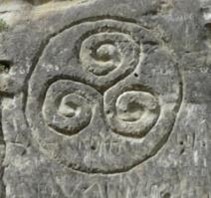
https://c.pxhere.com/photos/c6/42/stone_rock_steinzeichnung_relief_characters_ornament_pattern_triskelion-1149430.jpg
This symbol is the triskel.
And I refer you again to Professor Dendrinos’ article and his diagram of the site on page 14.
You will notice with me, I think that the site of Göbekli Tepe is conceived on this model.
What does it say about this symbol? :
The triskel, also spelled triskèle or triskel (in Breton) or also called triskelion or triscèle [from the Greek τρισκελης/triskelês, “triskeles” meaning “three-legged”], is a symbol representing three human legs, or three intertwined spirals, or any other symbol with three protrusions evoking a cyclic group symmetry.
The symbol has been found since the Neolithic period in various cultures and at different times. The oldest representations are found on the megalithic temples of Malta. The symbol can be found at the Neolithic tomb of Newgrange dated 3,200 B.C., at the site of Brú na Bóinne, in Ireland. In the form of an engraving, it is present in several places, notably on one of the large stones placed in front of the entrance of the monument. ” … ” The triskel is also used during Greek antiquity. From Agathocles of Syracuse, it appears on coins in Sicily, an island with three capes, of which it becomes the symbol. These regions are free of any Celtic past.
It is, however, considered an important feature of Celtic art during the La Tène period (Second Iron Age, 5th – 1st century BC).
The archaeologist and historian A. Grenier estimates that “the triscèle with three curved branches, the sign in S dear to the Gallic art, seem to have been originally symbols of the Sun” (The Gauls, p. 288). “One can advance, writes Ph. Jouët, that the dynamic symbol of the triscèle [in the Celtic area] represents the three moments of the visible career of the sun, morning, midday and twilight, the “fourth step” being done in the night. This does not preclude related meanings: three heavens, three seasons, three notions. “…” The direction of rotation of the triskel with curved branches assumes that the circular development floats back from the plane of advance (in the attached illustration, the typical triskel is dextrogyratory, like the sun).
https://fr.wikipedia.org/wiki/Triskèle
(In parentheses, note the pattern found in the plain below the site:
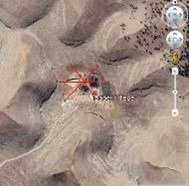
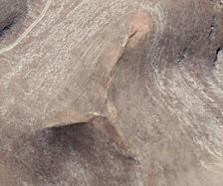
I close the parenthesis ;).
What does this mean?
In this symbolism of the triskel, of the three connected spiral circles, we see that each circle is potentially like a mini-matrix that allows us to reach the center, in other words, a state of perfection, but at the same time, each circle is connected to the others, and if we start from the right to the left, once one step is completed, another process (identical or not) continues with the next circle. Most certainly, if we join their centers, we will also find a perfect triangle. At the end of the third cycle (or trimester!) gestation is complete and rebirth can occur.
It is interesting to note that both Mr. Grenier and Mr. Jouêt have associated it with the sun and Mr. Jouêt with the phases of the sun. Even if he limits this explanation as often to a cosmic phenomenon. Given that it is obvious that the sun is a symbolic representation of the father of the gods and that its daily and annual cycle is used to represent its regeneration, it becomes perfectly logical to interpret the internal architecture of the triskeles temples, the very temple where its regeneration takes place, as having been thought out and conceived to represent, by its own architecture, the different phases or stages (crushing-beating-purification) prior to the rebirth.
This leads me to think, as we shall see for Malta or Newgrange in Ireland, that each enclosure (each egg) is not only a matrix in its own right where the rebirth of the father of the gods under the son occurs (at the winter solstice as elsewhere), but it can also be associated with a particular stage of the regeneration process. With this understanding of things, it becomes clear that it is only when the three circles have been crossed within the matrix which includes them, that regeneration is totally effective, all the stages having been crossed.
What seems to support this idea is, for example, the fact that enclosure D has a strong “vulture” connotation.
Now the symbolism of the vulture leaves absolutely no room for any other interpretation than the one I have delivered in its specific analysis (forgive me for being so peremptory, but it is an obvious fact, the Sumerian etymology is the seal of it).
The term vulture being a strict Sumerian homonym of the mortar, it is the emblem of the mother-goddess Eve and of her matrix under its character of destructive scavenger.
As a reminder, here is what we find in this regard under the symbolic analysis of the vulture and the mortar:
Te [Á] mušen is the name of the bearded vulture
It is remarkable that the cuneiform sign of “Te” is “Á”.
For á , áĥi, aĥ 5 , all three mean an arm, a wing, a horn, a side, a power.
If the wings evoke the wings of the vulture, the double meaning is obvious since Eve was known by “…” (and other phonemes) as the side or the goddess of the side.
Moreover, as if that were not enough, “te” is an equivalent of “ti” which also designates a side, a rib, an arrow (cf., te, dih, and tìl).
Tum also means an action, a work (and a traverse), a quiver. This links tum directly to aka, ak, ag, a5 which in their verbal form mean to do, to act.
“ti tìla, tìl” also means “life” by the contraction of “tu” “to be born” and of íla, “to raise, to carry”). It is undoubtedly always connected with Eve whose Hebrew name under “haya” means to give life.
Thus, “te” the vulture, is unquestionably an emblem of Eve-aka/aga, the goddess of the coast or side, the mother who gives life.
As for the mystical link between the vulture and the mortar, it is just as obvious:
To understand their close connection, we must look back at one of the Sumerian words for mortar:
Naña, or nañ
Naña, or nañ (synonyms of Gaz, Kum) means to crush (with nominative – a), but also by nañ, na8 the action of drinking, watering, irrigating, drinking from (with -ta-) (na8-na8 in marû) being the contraction of “ní” “body, self” of “a” “water” and of “áñ” “to pour, to supply”.
This term explains the very name of the Sumerian goddess Innana which means (among other things) the one who crushes and waters, sprinkles with water, but also with rich fluids. Indeed, Inanna can be broken down into “i” “na8-na8”.
” ì ” (or ia2, 7, 9) meaning oil, fat, cream, or by i4 (ia4) pebbles (or river threads), and by i7 (or ída) means river, main channel, stream (ída being the contraction of “ed” “generate” and “a” “water”).
Thus the mortar under Naña, or nañ, refers to the womb of the mother goddess who both crushes and is the source of sons, rich vital fluids and water.
It should be noted that naña also designates soda, alkaline, potash (used as soup), an alkaline plant, saponaria (nañ, “to drink” + a, “water”)
It is not useless to recall that alkaline plants or alkaline diets are reputed to have the virtue of deacidifying the body, purifying it and regulating menstruation.
Naña is thus associated with the purification of the being.
” … ” Thus, the mortar under nañ, naña also designates the fact that through the return to dust, pulverized in the matrix-flower of the mother-goddess, fallen humanity can see itself sanitized, cleansed, purified, regenerated.
There is also another meaning that this term naña conveys.
To understand it better, it is enough to transliterate it into its synonyms, assuming as it has been shown that “g” “k” “ñ” “ĥ” are equivalent in Sumerian.
So naña is equivalent to naga, or naka or naĥa.
Thus we find not only the name of the mother-goddess Eve, aga/aka/aĥa/aña, but also the mortar, since ĥa also carries the idea of a mortar with the action of mixing, grinding.
Once you have read this, you must then understand this:
If Te designates a bearded vulture, a vulture that is an emblematic symbol of the mother goddess Eve, it turns out that… Tè, its homonym, is also an alkaline plant, a saponaria, the cardamom exactly like the term “naña” which designates… the mortar!
Thus Eve the side, the side the mother of life, the vulture and the mortar are synonymous, intimately linked, intricate, by their etymology!
What will be then astonishing to see the great mother-goddesses, of which Rhea, the Egyptian Maut, Nekhbet, until Isis represented under the shape of a vulture?
Or what would be surprising to read for example this about Isis:
The vulture is sometimes identified with Isis, in the Pyramid Texts. The mysterious words of Isis, those which confer life, must be known to the deceased. The possession of the prayer of the vulture will be beneficial to you in the region of the thousand fields. It is in the night, the darkness, the death, that the vulture goddess revives the soul that will resurrect at dawn: The vulture (the mother) conceived in the night, at your horn, oh pregnant cow ” . The vulture is also represented on a basket or a basket, symbolizing the germination in the womb. (CHEVALIER-GHEEBRANT, Dictionary of Symbols, 2005, p. 995)
Or what would be the surprise to read that in Russia, “the old ogress Baba-Yaga, personifying the winter storms, travels in a mortar: in the mortar she rolls, with the pestle she digs, with the broom she erases her trace. (CHEVALIER-GHEEBRANT, 2005, p. 862)
It is necessary to understand by it “travels in a mortar” that it flies like a bird while being in a mortar as in a basket.
The mortar of this old witch “baba-yaga” being none other than the matrix “ba” of “aba” the father and the fluids “ia” of “aga” “eve”.
…
There will be none, just as there will be none to see on this site of Göbekli Tepe, a “simple” site of the regeneration by the matrix of the mother-goddess, to see her under her symbol of the vulture and the mortar, operate the first stage of the regeneration, namely the destruction, the pulverization, the crushing, the mixing, of the body of the deceased.
From the presence of the vulture in circle D, it is obvious that it is particularly attached to the process of destruction.
The fact that this step is in the middle makes sense if we assume the following:
Let’s ask ourselves a simple question: since we are on sites of rebirth of the deceased into a regenerated being, into another individual, how long is the gestation of a human?
9 months (reminder: the wheat cycle is also 9 months to reach maturity…)
So if we divide 9 months into three distinct stages, we will have in the left circle (usually west) the phase of fertilization, in the middle circle the phase of destruction, whether by fire and/or mortar (usually north), in the right circle the phase of churning/churning (usually east), and coming down in the center (usually south, the moment of rebirth with the call to light of the winter solstice).
THE ANIMAL SCENOGRAPHIES ON THE DIFFERENT PILLARS
It is necessary to be able to examine all of them in order to consider defining the precise story it tells.
Stone 43 of the enclosure D
The only one that I have been able to find from the information I have been able to gather so far is that of pillar 43, which is located to the north of enclosure D, also to the north, and which is therefore the enclosure where the vulture predominates.
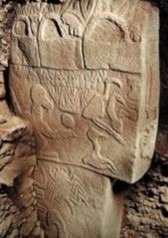
What jumps out at us in this scenography is the fact that a vulture receives an egg or a grain from a basket-funnel made up of various baskets arranged in a circle and which form a crown around the “head” of the orthostate. The egg is visibly on the right become large, in the form of a baby vulture, visibly then also fed by its mother (on the right of the fresco), all under the gaze of the scorpion below (but separated by the line of the head).
In itself, given the matrix symbolism of the basket and the basket (the theme of the basket is also taken up in the rites of Isis, Artemis…) and given the symbolism of the grain of wheat as well as the egg, it is more than obvious that we are witnessing the rebirth of the father under the son, in this case the baby condor.
Even without knowledge of Sumerian and all the symbols, given what is simply available in the dictionary of symbols of (CHEVALIER-GHEEBRANT, 2005) as for the symbolism of the vulture and the basket which is intimately associated with the mother-goddess and which I have just reminded you (the vulture is the mother, it is represented on a basket which symbolizes the germination in the matrix: it is thus not of me), it is necessary to be frankly quite blind (or quite obtuse, it is according to) not to understand what it is about.
Unless no, I am wrong, it is probably indeed hunter-gatherers who were learning to domesticate vultures for hunting … Finally, where was my head?
Anyway, let’s continue.
The fact that a headless man is represented on the same stone in an ithyphallic position, with his sex erect, goes in the same direction as the logic of the representation of the regeneration of the father in the son, the baby condor/vautour.
Let us recall that when they were condemned to death, the first human couple was represented without heads (for Adam in the form of the headless bull, the stump of the tree, etc. see volume 3 and the analysis of the death sentence by the Logos). This stone thus shows him in his fallen form, without a head, i.e., condemned to death in Eden by the Logos of God (of which the scorpion is one of the initial meanings). It also shows him as having, by his erect and victorious phallus, impregnated his wife before dying which, thanks to this symbolic pre-mortem conception of his future son, finally allowed him to be reborn by means of the matrix-mortier-corbeil of his wife the goddess-Eve-vautour-mortier by reincarnating into his son to reappear here under the baby vulture son.
The eternal loop of the death-regeneration of the Father of the Gods is once again represented and closed by this (other) figurative scene, which says strictly the same thing as the animal totem, but with just different symbols!
The struggle between the snake and the fox
I have also read (without being able to find the source) that a motif represents a fight between a snake and a fox.
This is particularly evocative, for in the struggle to the death that was analyzed in volume 3 between Titan and his posterity and the Father of the gods and his posterity (review the symbolism of the Fox; volume 3 Titan’s propaganda war; Titan’s necessary adaptation to the prophecy of Genesis 3 : 15), the fox was in one of its first symbolisms an animal representation of the Logos of God, adversary of Titan and its terrestrial representatives (which took for example the form of the canid Seth in Egypt), while Titan was as for him represented, in this fight under its original symbol of the snake.
The symbol of the fox will also become a symbol of the esoteric Logos, the one taking over a symbol of his opponent.
It is therefore not surprising to find this struggle depicted in this place.
It can simply mean two things:
- The struggle between the posterity of the Judeo-Christian messiah and Titan
- The victory of the esoteric messiah and his victorious struggle over the serpent, in a reprise to his advantage of the prophecy of Genesis 3:15, in order to substitute himself in the hearts of the true messiah
The central question opposing early Judeo-Christianity to esotericism being, in particular, the question of the intrinsic immortality and divinity of the human soul, and in the first place, that of the first human couple (did they really die or did they have access to immortality?) it is logical to find this prehistoric scene described under these mythological symbols in the very place where the masses of the time were taught that the regeneration of the father of the gods had taken place
EXPLANATION OF THE PRESENCE OF MORTARS
The symbolism of the mortar has been amply evoked not only by its complete analysis provided in Book 2, but will be incredibly illustrated in the course of the many sites examined.
I invite you to read it again and to pay attention to what will be said in the analysis of the temples of Malta in particular.
We must simply understand that the mortar is, like the cave or the cauldron, the place where death takes place, in the precise case of its use, the “crushing”, the symbolic annihilation of the killed, the sacrificed, to allow him to be then regenerated into a new being, while producing “food” supplied by the mother goddess to her worshippers to allow them to acquire immortality. The mortar thus carries the idea of death, of destruction induced by going to the underworld, the return to the matrix, prelude to its future rebirth and to a production of abundance.
You can see that there is absolutely no surprise in the “abnormally high concentration of grain crushing instruments“, with mortars with cylindrical or conical pestles.
Are we going to see, like Mr Trump of the site of the megaliths of Malta, a grouping of hunter-gatherers who discover the joys of agriculture and happily grind flour all together, to “create a community link” without any sacred or cultic sense, and who, to do so, engage in a work of Titans for decades or hundreds of years, or finally? Like Mr Ferguson, a mystical link with the symbolic cult of the mother goddess who, as we have understood, by her matrix when symbolized by the mortar needs to grind her husband (then her devotee), symbolic grain, to better rebirth him 9 months later under a new being, a new purified grain?
EXPLANATION OF THE PRESENCE OF HUNTING TOOLS
The same is true for hunting.
The archaeologists of the site have noted the presence of numerous tools related to hunting as well as animal remains (above all gazelles, aurochs and wild asses) corresponding to the fauna that was then found around the site.
It has already been said that the presence of these animals may be related to the animal avatar or deity who claimed them as a sacrifice and was able to share them with the devotees.
But we must not forget, first of all, the symbolism of the hunt.
This one was exhaustively examined in volume 1 as being part of the rites of sublimation to be carried out during one’s lifetime (review the symbolism of the hunt, of the archer, of the hunt for the doe with bronze feet…).
Let us simply recall here that the meaning of the word sin is “to miss the goal” or “to miss the target”. So the symbol of the hunter and more particularly of the archer (or the one who handles the slingshot) with perfect dexterity by reaching his target, symbolizes the recovered perfection, sign of the sublimation reached for the one who had lost it and thus of his transformation into a star divinity in his own lifetime.
To find so many hunting tools in this place of worship undoubtedly attests to the practice of this sublimatory rite. Perhaps the weapons were then donated to the couple of gods on site, which would explain the reason for having left them there.
Obviously, the consequence of both the demands of the mother-goddess for sacrifice, the abundance of game that she promises to provide in return to her servants once her rites and sacrifices have been completed, as well as the practice of this sublimatory rite of the act of hunting, perhaps requiring the blessing of the mother-goddess on the hunting weapons, has no doubt concomitantly contributed to this accumulation of so many hunting implements on site.
REASONS FOR THE ORIENTATIONS
BECAUSE OF THE REPRESENTATION OF THE THREE STARS OF THE ORION BELT
Since we are talking about the hunter, let’s come to Orion.
First and foremost, I do not believe in aligning with constellations when building for two major reasons:
- This presupposes that the ancients were not aware of the constellations and needed to align themselves with it in order to make sense.
- The dating necessarily leads us to time slots that are too far removed from the reality of the moment of their construction. Moreover, they would have been understandable only for a time.
However, I remain personally convinced that :
- With these builders, we were already dealing with outstanding astronomers. It was enough to evoke the Orion Belt for them to associate the site with this belt without necessarily having to align themselves with it.
- The vocation of these sites is to remain timeless. The alignments with the sun in its daily or annual lunar rhythm are immutable. On the other hand, to seek an alignment involves a dephasing of the site in the medium long term what they knew and did not wish nor seek. In order to remain timeless, all they had to do was to represent on the ground all or part of the constellation that they wanted to evoke and associate with the site.
So, yes to the possible representation of Orion’s belt, but no to its alignment with the constellation during construction.
With this in mind, the evocation of Orion from a symbolic point of view is very attractive and fits perfectly with the site whose goal is, like all the other sites, the transformation of the father of the gods into a star.
The fact that it is under the symbol of the hunter, or even of the archer (Orion seems to be holding a sling and a shield, but one can also see a man having shot his arrow from his bow), is quite possible and highly judicious from a symbolic point of view. The message being that having erred, having sinned, having missed the mark as a man, he has nevertheless, as esoteric doctrine teaches, mystically redeemed himself, having sacrificed himself and having been regenerated by the womb. As a result, he is now enthroned divine among the stars as the perfect archer-hunter, who never misses his target (again). He has become perfect again.
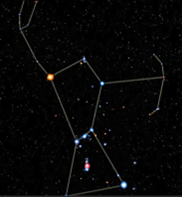
BECAUSE OF THE ALIGNMENT ON THE SOLSTICES AND EQUINOXES
It is known that this site, like the great majority of other megalithic sites, has an annual alignment on the solstices and equinoxes.
(re)here is the cycle that I think is phased between on the one hand the cycles of equinoxes and solstices and on the other hand the 4 major stages of the mystical gestation preceding the regeneration (see the symbolism of the solstices and equinoxes in volume 3) :
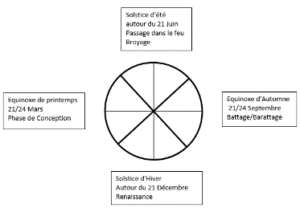
Insert texts from left to right, then clockwise :
- Spring equinox (March 21/24): Generation phase
- Summer solstice (around June 21): Passage through the fire and grinding
- Autumn equinox (September 21/24): Threshing or churning
- Winter Solstice (around December 21): Rebirth.
Each of the thickly outlined neighborhoods corresponds to a different stage of the regeneration process.
It is not in contradiction with the triskel because the fourth stage is that of the rebirth which corresponds to the corridor of entry or to take again the symbolism of the cross, the axis of the bottom of the cross.
The question was therefore for the architects of each megalithic site, wherever they were, to determine first the orientation of the site, from the point of entry, from the door chosen so that the sun would come to strike each middle of each quarter, or at least the zone of this quarter, to correspond to the indicated phasing of the gestation cycle.
Depending on the point of entry of the chosen light, they placed :
- Either the axis of the structure in such a way that the sun at the time of the winter solstice comes to hit directly the center of the district dedicated to the rebirth.
- Either they used stones to reflect the incoming sunlight onto this central area.
The important thing is that on this date of the winter solstice, the center of this district or at least this area is, in one way or another, by a direct or indirect light, illuminated at this time in order to call the deceased to the light, so that he leaves his grave, the womb, being born again now that his gestation was completed.
The same principle is valid for centers or areas of each neighborhood.
The sun had to strike, directly or indirectly, the center or the area of this district at the precise moment of each equinox, solstice which was related to it as in the diagram above.
This is, I think, the universal rule of thumb for this type of building dedicated to the renaissance.
It is then understandable that not all sites dedicated to the renaissance necessarily had an eastern entrance, since it was “sufficient” for the designers to play with the reflection stones, so that each area would be illuminated at the right time.
In the case of the temple of Göbekli Tepe, the entrance as presented by Mr. Dendrinos in his diagram of the temple is visibly to the south and he puts particular emphasis on an alignment that can be seen on the summer solstice.
On the Arcana site, we find the orientation in relation to the sun, the point of entry of the light as coming from the east (and not from the south) and generating the alignment on the solstices and equinoxes.
Since each enclosure had windows, this may be the reason for this difference in orientation of the major point of entry of light on site.
One thing is certain, the exit of the deceased from the cosmos would normally occur at the winter solstice, a highly symbolic moment when the sun is called to be reborn. It is unlikely that the summer solstice was chosen to symbolize this rebirth, even if, as it is the moment when the sun is at its strongest, it could have been considered by certain peoples as the moment chosen for the elevation of the father of the gods to the rank of the stars, which in this case would simply shift the phasing between stages of gestation and the rhythm of equinoxes and solstices.
REASON FOR THE SHADOWS
In connection with what has just been said, it is interesting to note Mr. Dendrinos’ remark that a choreography of shadows (and therefore of light) is evident on the site, with, each day and each night, within the enclosure, a shadow of a pillar coming to lean or appear on another pillar, at a precise moment of the day, and this, between all the pillars, including the central pillars between them, the whole in a ballet making him evoke the imagery of a couple.
In this regard, it is very useful to refer to the symbolism of the shadow.
For the record, one of the Sumerian words for shadow is an-dùl
An-dùl also means protection.
If we break down this word, its meaning becomes extremely interesting.
An designates the father of the Sumerian gods since this is how he was named.
Let us review the etymology of “An” as provided in the symbolic index of Sumerian phonemes in volume 3.
Reminder of the etymology of “An”:
“An” as it is means heaven, paradise, the father of the gods An; “…” in its verbal form, it means to be on top “…”
Since “a” and “e4” are equivalent, “an” is homophone of “en” which means a dignitary, a lord, a high priest, an ancestor, a statue…
How did the phoneme “an” come about?
“a” or “aa” means father
As for “n”, it means “to be elevated (exactly like the phoneme “íla, íli, íl” “to be raised”)
It is then easy to understand why An is the father of the Sumerian gods.
It is literally a father ancestor elevated to the rank of gods, to heaven.
This etymology allows us to understand that An is not a father of the gods, as if he had always been a god, but more exactly a human ancestor, a father, a high priest, who became a god, after having been raised, during his lifetime or after his death.
Indeed, elevation implies that there was previously an inferior or lowered state. A real god does not need to be elevated since he is by nature already “on top”.
Brief reminder of the etymology of “dul
It is not possible for me to go into the etymology of this word here, because it is very rich, very full, and it has been exhaustively examined in the appendix under different precise analyses (review the analyses of the symbolism of the cave [dul6 or du6], of the tell, mound, [dul6, du6 ] of the cauldron [udul or utul], of the oven [udun], etc. ).
It will be a question here for us to simply remember that it is a very important phoneme which conveys by itself with its homonyms a good part of the process of regeneration of the great god operated by the matrix (recall: for example du10 or dùg designates the vagina; dul3, 4, 5 means a protection), a process which is declined in several stages of which du/dul evokes the major actions which are carried out there in several key stages: the killing, the correction (by ba[ra]tting), the purification (by cooking or balancing), the regeneration (by redemption, liberation, [re]shaping to perfection, and the birth again).
In connection with the symbolism of the shadow, it is, I believe, useful to recall here one of the meanings of “dul” relating to the action of redemption or ransom.
Here is what was seen:
dul3, 4, 5 equivalent to dal, means protection and in its verbal form cover, dress, protect, hide.
Now, the action of clothing represents in particular the restoration to an approved condition (review the symbolism of clothing). It is linked to the action of covering which designates the triple action of protecting, hiding, but also and above all redeeming (see symbolism of covering).
Reminder of the symbolism of cover: If the Greek word for ransom, “lutron”, comes from a verb meaning “to untie” (it indicated the sum paid to free prisoners of war), the Hebrew word for ransom is “kopher”, which comes from a verb meaning “to cover” or “to cover”. (it indicated the sum paid to free prisoners of war) the Hebrew word used for ransom is “kopher” which comes from a verb meaning “to cover” or “to cover”. Noah’s ark was “covered” (kaphar) with tar (kaphar) with tar (Genesis 6:14).
To pay a ransom is therefore to cover “the iniquity of someone” or “someone”. Psalm 65:3.
Hence also the Arabic term for Allah called “raffur” meaning merciful, which literally also means “the one who covers” in the sense of forgiving faults).
We thus understand that the symbolism of the shadow is very loaded, because it is etymologically and thus symbolically associated with the regeneration of the father-ancestor to make him a god, an operation that the matrix carries out, whether it is a cave, a mound, a mound exactly where we are with this mound of Göbekli Tepe, and this in the respect of its various stages that I have just reiterated.
Thus, the “shadow” “an-dul” literally means “the cave, the tell, the mound of An”!
We have seen it in their respective analysis, also what covers and protects it to make it a star!
Indeed, “dul” is a contraction of “da” and “ul”.
Now one of the first meanings of “ul” is “star” and we know that the star is notably the symbol of the reaching of the sky of deification for the deceased (please review the symbolism of the star).
This covers and protects him because it is the very meaning of “da”:
Da designates an arm, a side and in its verbal use it has the meaning of being close, of protecting, holding, maintaining,
And you understand it now easily with what has been said previously in these analyses and in that of the symbolism of the coast, of the side, an-dul does not simply tell us that it is there a place (the cave, the mound, the tell) or a thing (the shadow, of the matrix) allowing to redeem the father of the gods; this term ” dul ” also tells us who is the owner of it since it questions by ” da ” of the side, of the coast, in other words of the companion, of the assistant of the deified original father-ancestor, namely Eve.
The two central orthostats are all the more easily identifiable!
Since we are on the symbolism of the shadow, it is also, I think, useful to remember that another word for shadow is ” ñissu or ñizzu ” which has/have as cuneiform sign “ÑIŠ.MI”.
Let us briefly review the meaning of ñis, of “su” or “zu” and of “mi” in order to understand the mystical significance of this shadow.
The meaning of “ñis”:
” … “
niš is a very common term, in Sumerian, because it is used to mean generically, an object, a tool, a wooden instrument, since niš also means wood. That is why it is often found in front of another word, essentially to define the fact that it is an instrument.
” … “
ñiš, ñeš designate a tree, a sceptre, a symbol of domination ” .
” … ” Note also that she can be a tree. Now the tree is a symbol of both the father of the gods and the mother-goddess, herself often incarnated as a tree. So if this symbol appears to be strongly connoted masculine, it can also represent and embody the great mother goddess.
Thus, we understand that the shadow can be symbolically an instrument, a means and a symbol of domination and power.
But for what purpose is this shadow used?
Who does it belong to?
The meaning of “su” or “zu”:
This phoneme has been the subject (also!) of a thorough etymological analysis.
It is indeed very busy, important and its analysis is therefore particularly interesting.
It is available in the analysis of the symbolism of nudity.
Why in the analysis of nudity?
Because…
The term “su” used as an adjective refers to being naked, in a nominative usage, the body, the flesh the skin as well as a substitute, a replacement.
When we analyze it, we finally realize that this simple little word, “su” for “naked” by the multiple meanings of its phonemes, allows us to identify a good part of the ambivalent meanings of nudity, which must be understood as being evolutionary, progressive, starting from the lost nudity to the recovered one, passing through the stage of human decay consecutive to the Adamic sin.
It includes indeed the following stages (that I will not be able to detail all here): a state of happiness (initial) , followed by a state of decay (intermediate), followed by a possible redemption thanks to the matrix, followed by a return to nakedness then symbol of regeneration.
I will limit myself to expressing what is directly related to what we say here, with :
Part of what was said in the “initial happiness” section:
It should be noted that su11 (equivalent to zú) as well as sú (equivalent to zu) means knowledge, wisdom, among other things.
In their verbal usage, they mean to know, to understand; to inform; to learn from someone; to recognize someone as qualified, skilled
So that “su” is also the symbol of a state of knowledge, of wisdom, a positive indicator of a state of perfection.
We see here the meaning of zu which means knowledge, wisdom.
The analysis of “su” in the buyback section reads as follows:
To dive into the ambivalence of the symbol, it is necessary to note that súg, su8 means, it seems, to stand upright (cf., gub, súb) by being according to the lexicon the contraction of “su” “body” and “long and straight”).
This idea of standing up may recall the idea of standing up in a spirit of rebellion (and the symbolism of Titan under the snake standing up), but also the fact that the human stood up, because he was given hope to get out of this bad situation.
It should then be noted that sud4, su13 means in their verbal use to be long, to prolong, to lengthen, to last, to give, to present, to offer (adjective, long) and that above all, sug6, su means to replace, to restore, to repay (a loan, etc.) (cf., rúg) by being according to the lexicon the contraction of “to fill” and of “entry, room, tank”.
Thus, “su” implies the idea of ransom, since it is a question of restoration, replacement, repayment of a debt (symbolically of a sin) allowing the human being to stand up straight, and to lengthen his shortened life.
Moreover, the word “su” means in its nominative usage, the body, the flesh, the skin as well as a substitute, a replacement. It is thus clear that the flesh, the body is conceived as a possible substitute ransom of the human being.
” … “
Don’t you think that the link is quite obvious with the monoliths and standing stones in a general way that represent the deified ancestors, and here with the orthostats of Göbekli Tepe straight and long, with these two beings dressed in simple loincloths and who shade each other by covering themselves, redeeming themselves in a cycle by stages?!
This is what we read in this analysis of “su” in the part relating to nudity, a preliminary stage to regeneration:
During the analysis of the different stages allowing regeneration, it was observed that the great god, as well as the being walking in his footsteps, that is to say the esoteric initiate, must accept to sacrifice himself, to make a sacrifice of ego or of himself.
This operation is also symbolically conveyed by the word “su”, because if the first meaning of “deprivation” is that of our first parents who lost their attributes and perfect faculties for having been selfish, esoterically, by carrying out the opposite process, that is to say, by sublimating oneself, by depriving oneself of one’s selfishness and bad thoughts, it is possible to regain the lost perfection.
This is why stripping is also taught in esotericism as a necessity for the initiated human being.
So that if su3 (equivalent to sud, sug4) carries in verbal mode the sense of stripping, stripping, emptying, being according to the lexicon the contraction of “su” “body” of ig, “entrance” or even of mug2 “nudity”), we note that su7 (sug8 sul4, sur12,) is a threshing floor (of the grain) or a pile of grain.
gisu – su is a basket (repetition of “su” threshing floor)
Knowing the symbolism of the basket which is that of the matrix (review the symbolism of the basket) of the threshing of the grain which consists in stripping the grain, which represents the action of putting to death the great god before his regeneration, “su” thus conveys the idea of sacrifice of the great god, then of its threshing, its crushing (revisit the idea that súd means the fact of crushing, of crushing [of gnashing (of the teeth) which is applied here in another sense] in order to allow it to purify itself, to keep only the best of itself and thus to self-purchase in order to be reborn.
If we synthesize what we have just said, what should we understand mystically with the shadow ñissu or ñizzu?
She is the instrument of a wisdom, of a particular knowledge, that of knowing and recognizing for her devotees that the matrix of the mother-goddess will allow them, once dead and returned to her, as she did to the father-ancestor, by the same acceptance of death lived as a sacrificial act, by agreeing to let themselves be beaten, crushed, punished for their misdeeds, that they will be able to resurface from it, naked and perfect, redeemed, such as the stars, the gods
And if one doubts that the real shadow that redeems them in a particular regenerative cycle is above all that of the mother-goddess and her womb, it is necessary to remember one of the first meanings of “su” which is substitute, replacing”, in the sense of spouse, companion, assistant of the father of gods (review the symbolism of the side, of the coast).
But also the meaning of “mi”, because let us remember, the cuneiform term equivalent to the shadow ñissu or ñizzu is ÑIŠ.MI which means, as we have understood, the instrument, the symbol of the power “ñis” of “mi”.
Who is “Mi”?
Let me remind you:
me or its equivalents ñe and mi designate the power of the great deity.
mi is a very important symbolic phoneme. It designates with all its equivalents (gíg, ñíg, gi 6, ge6, ñi6, ñe6, mi, mé, ku10; gi25) the night as a dark and humid cavity like the throat or the mouth (or the womb);
“mí” refers to a “woman”, a female [like “mu10, munus”].
Let us also briefly recall one of the meanings of “mu” to which “mi” is thus associated:
Mú (or Mud6) means to sing, to blow, to light, to ignite, to make grow while mù (or ma5 with the cuneiform sign ka׊È) means to grind, to grind, to burn. Ka še means the door (ka) of the grain (wheat..) of the rain (še 7) of the excrements, of the manure še 8
“mu” or “mi” thus designates the power of the mother goddess, dark, or the dark cavity, the “door” (understand the entrance to the matrix) of the grain, of the individual she grinds, mills, burns in order to make it grow. (understand the entrance to the matrix) of the grain, of the individual that she grinds, grinds, burns in order to make it grow. The consequences of this process are not only the regeneration of the deceased, but also his gift to her of his vital bodily fluids: rain-urine, excrement-manure.
Also note:
One of the homophones of “mu” is mur10, mu4 which means to dress or get dressed
Thus “mi” allows the deceased by regenerating them to be symbolically re-clothed, in the sense of being restored to an approved condition exactly as the couple of gods, such as the two central orthostats are themselves….
It is therefore not surprising that the shadow of the pillars was the object of such interest on the part of the builders, who were certainly not ignorant of what has just been said, to make them lean on each other in this way. No doubt, both to indicate the change of a stage in the mystical gestation, associated with the calendar of the day as well as the year, but also to indicate that at this stage such and such a divinity symbolically “covers” the other, i.e. protects him and helps him to redeem his faults.
It would just be interesting to know the avatar assigned to each T-pole of the perimeter, the precise cycle of the shadow from daybreak to evening and at key times of the year, in order to be able to determine how it fits with the phasing of the different stages of regeneration.
SYMBOLISM OF FLUIDS
HYDROGRAPHY AND FLUID SYMBOLISM
It emerges from the study of the site that, unlike many other megalithic sites that we will analyze, there is no spring or river nearby.
However, since the situation of this region may have undergone great upheavals (especially at the time of the last ice age of the Recent Dryas), it can be assumed that this was not always the case, at least not at the time of the design of this site (assuming that it was built before).
In any case, the area has always been a fertile region since, today, Mr. Dendrions indicates that “flat, abundant and fertile agricultural lands are located south of the site”.
(Gobekli Tepe: a 6 th millennium BC monument/Dimitrios S. Dendrinos/15/11/2016; p.9)
MANIFESTATION OF THE SYMBOLISM OF FLUIDS
You have noted that although there is no water source near the site today, cisterns have been located on the limestone plateau above it, but their capacity is 153 m3, which is considered too limited to supply a village with water. Large limestone containers were found, the presence of a vat, the engraved representation of small cups, and the practice of inebriation rites with the presence of beer and/or fermented drinks was highlighted.
In such a ritual context, knowing the meaning of fermented beverages and mystical intoxication, it is obvious that we are faced with a cult of the fluids of the crouching mother-goddess (see again the chapter dedicated to the symbolism of fluids with an explanation of the symbolism of beer associated with the urine of the mother-goddess).
EXPLANATION OF THE CULT OF SKULLS
It is also very interesting to note that on this site a cult of skulls was practiced.
This is just further confirmation, if any were needed, that we are on a cult site dedicated to the regeneration of the Father and any deceased ancestor by means of the matrix.
Indeed, the most important symbolism of the skull is that it represents the cave, in other words the womb of the mother goddess. Making a hole in its top represents the omphalos of the vault, the navel of the womb of the mother goddess, through which the deceased will emerge born again.
The thread by which he is suspended represents the axis by which he will reach the center of the circle by his elevation in a straight line, thus reaching divinity and perfection.
I invite you to consult volume 3, the symbolism of the skull [but also the symbolism of the post (where we see that the couple of gods in their fallen and sacrificial condition was represented as hanging, or suspended) the symbolism of the thread and the spider…].
I mean, no no, aren’t we on “navel hill”??!
What is so extraordinary about this, frankly? To note the presence of a cult of skulls which is just another representation, different, simply smaller, microcosmic, of the power of the matrix of the mother-goddess to transform the former occupant of this skull-uterus, into a divine being, by making him come out through a hole at the top, his omphalos, his navel, exactly what the mound itself does symbolically, on this “navel hill” on a larger scale!
Not understanding it, from a symbolic point of view, is just a (bad) joke!
EXPLANATION OF THE PRESENCE OF PHALLUS
Concerning the presence of phallus, it is very logical.
First of all, let’s remember that the symbol of the phallus is multiple, depending on its context and isolated or not, it can designate the fertilization by the father, its elevation or also the vagina of the mother-goddess expelling it towards the stars.
(review the symbolism of the axis, the post, the column…)
Moreover, given that we are on the very site of the reincarnation of the Father, who required before dying that he impregnate his wife so that he could reincarnate in their son-messiah to come, the presence of a fertilizing phallus is necessary.
This does not indicate the presence of a patriarchal cult at the expense of a matriarchal cult! Both are present!
The Father of the gods is adored and worshipped on this site since he is the regenerated being.
The Mother Goddess is also adored on this site as she is the means.
Certainly, and this book demonstrates this, the worship of the mother goddess by this means has risen above the worship of the father and the son, but this does not mean that they are not both present.
Neither should we see in this cult of the mother goddess what we are looking for in the recent exasperation of the modern and very stupid struggle between the sexes, that is to say for some, machists, the supremacy of man over woman or for feminists, the supremacy of woman over man.
It is a question of a religion that Titan dictated to men, to which they believed, submitted themselves, without for all that, men, for example, do not respect more (or not) their own woman.
Worshipping the mother goddess certainly did not, and never will, prevent the male devotee from beating his wife upon returning from the ceremony.
If this cult generated a respect, or rather a morbid fear, it was that of the elders, the dead, and among the living, the officiating priests, and no doubt also among the living of the role of their mothers, but probably not of the woman as such.
EXPLANATION OF THE PRESENCE OF LARGE LIMESTONE RINGS
It is also question on site of the presence of large rings of limestone.
This is not surprising either, since the ring is closely associated with the symbolism of the circle, which was exhaustively analyzed in Volume 3 and repeated in this volume. It is undoubtedly also a matrix symbol which finds its place perfectly in this place.
REASON FOR THE BURIAL OF THE SITE
It is also interesting to note that this site has been completely buried.
From the observations made, it appears that at first, the burial of the site was carried out of hand of men so as to hide it while trying to maintain it in the state without being able to finish.
After that, he was finally buried in a way that Mr. Dendrinos described as malicious, that is to say, in order not to allow him to reappear.
The dating of the events of its construction and its first burial, which could be placed before the cataclysmic events of the Dryas, and then its second burial, which could be dated afterwards, since we are dealing with two completely distinct populations at these two moments of history, goes in the direction of interpreting these events as indicating, in a first time, a hegemonic domination on site of the universal prediluvian esoteric religion, which ends up, in a second time, by knowing a time of stop with the events of the great flood, as long as Shem and his kind dominated the spiritual world of the time.
Even if the esoteric cult was going to take again later, its lost dimension under other forms that we will see, the site of Göbekli Tepe, him, sank in the lapse of memory before resurfacing without never being understood. Until today…
GÖBEKLI TEPE
- https://fr.wikipedia.org/wik/Göbekli_Tepe.
- WK/Klaus Schmidt 2011 « Göbekli Tepe : A Neolithic Site in Southeastern Anatolia ».
- https://www.youtube.com/watch?v=6VKKIOb0ZpU.
- Oliver Dietrich, Çiğdem Köksal-Schmidt, Jens Notroff et Klaus Schmidt, « Establishing a Radiocarbon Sequence for Göbekli Tepe. State of Research and New Data », Neo-Lithics, nos 2013/1, 2013.
- See authors of the article (Dietrich L, Meister J, Dietrich O, Notroff J, Kiep J, Heeb J, et al.). — Dietrich L, Meister J, Dietrich O, Notroff J, Kiep J, Heeb J, et al. (2019) Cereal processing at Early Neolithic Göbekli Tepe, southeastern Turkey.
- https://trustmyscience.com/plus-ancien-temple-monde-construit-selon-grand-plan-geometrique/
- Gobekli Tepe: a 6 th millenium BC monument/Dimitrios S. Dendrinos. 15/11/2016.
- Klaus Schmidt, ‘Anatolia’, dans Daniel T. Potts (dir.), A Companion to the Archaeology of the Ancient Near East, Malden et Oxford, Blackwell Publishers, coll. « Blackwell companions to the ancient world », 2012.
- https://www.youtube.com/watch?v=wLK4iCswLKE.
- Site Arcana : https://www.youtube.com/watch?v=6EIZYWwSZAs
- Actual Archaeology. Summer 2012
- Klaus Schmidt, « Göbekli Tepe: A Neolithic Site in Southeastern Anatolia », dans Sharon R. Steadman et Gregory McMahon (dir.), Handbook of ancient Anatolia (10 000 – 323 B.C.E.), Oxford, Oxford University Press, 2011. 918, 919)
- Joris Peters et Klaus Schmidt, « Animals in the symbolic world of Pre-Pottery Neolithic Göbekli Tepe, south-eastern Turkey: a preliminary assessment », Anthropozoologica, vol. 39 « Domestications animales: dimensions sociales et symboliques. Hommages à Jacques Cauvin, Villeurbanne, 21-23 novembre 2002’, no 1, 2004/p. 182-183 et 206-208
- https://www.youtube.com/watch?v=wLK4iCswLKE
- https://fr.wikisource.org/wiki/Dictionnaire_classique_sanscrit-français/अ
- https://sanskrit.inria.fr/Heritage.pdf
- https://ci.wolfgangpetersen.net/1810-neolithic-rock-art-found-in-india.html
- https://gurukulamtrust.wordpress.com/2013/05/
- https://c.pxhere.com/photos/c6/42/stone_rock_steinzeichnung_relief_characters_ornament_pattern_triskelion-1149430.jpg
- https://fr.wikipedia.org/wiki/Triskèle
REMINDER OF THE LINK BETWEEN THIS ARTICLE AND THE ENTIRE LITERARY SERIES “THE TRUE HISTORY OF MANKIND’S RELIGIONS”:
We have summarized everything that has been said or discovered about the Göbekli Tepe site in a separate article, also available on this site:
GÖBEKLI TEPE: SUMMARY OF ARCHAEOLOGICAL DISCOVERIES
article also taken from the book available on this site:
The megalithic temples of Malta, Göbekli Tepe and Stonehenge
You can also find this book here :
Already published books
To find out why this book is part of the literary series The True Stories of Mankind’s Religions, go to page :
Introduction / Structure and Content
COPYRIGHT REMINDER
As a reminder, please respect copyright, as this book has been registered.
©YVAR BREGEANT, 2021 All rights reserved
The French Intellectual Property Code prohibits copies or reproductions for collective use.
Any representation or reproduction in whole or in part by any process whatsoever without the consent of the author or his successors is unlawful and constitutes an infringement punishable by articles L335-2 et seq. of the French Intellectual Property Code.
See the explanation at the top of the section on the author’s policy for making his books available:
Already published books
